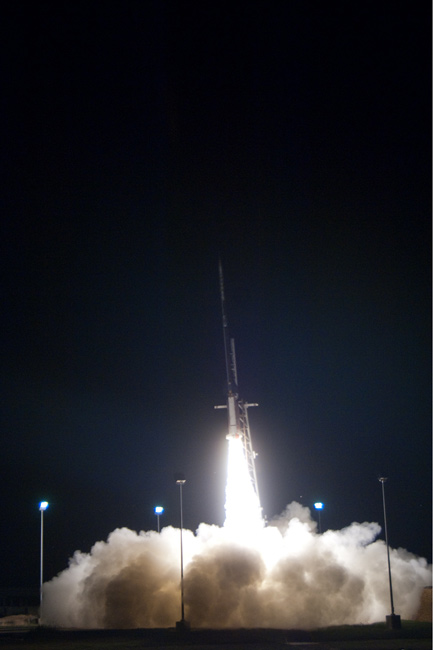NASA Rocket Lights Up Predawn Sky Above Virginia

A suborbitalNASA rocket lit up the predawn sky above Virginia early Wednesdayduring ademonstration flight to test one of its main motor.
Thethree-stage Black Brant X rocket blasted off at 5:15 a.m. EDT (0915GMT) from NASA?slaunch range at the Wallops Flight Facility at Wallops Island, Va. [Photo:Rocket's predawn launch.]
The launchwas aimed at testing new Nihka motor and a variety of other toolsincludingvideo and ignitions systems.
Soundingrockets are researchrocketsused to testequipment or processes for their appropriateness in a spaceflightenvironment. Theycan also be used to launch experiments to study the atmosphere or spaceenvironment.
In thiscase, the main component under test is a third stage Nihka motor, asolid rocketmotor which hasn't been updated for about 10 years, saidWallops FlightFacility press officer Keith Koehler.
NASA hasplenty of the Nikha motors in storage, but recently ordered a new batchand wantedto make sure they worked properly, Koehler said.
Theproduction and management of Wednesday's launch was conducted byNorthropGrumman, which is in the waning months of a 10-year contract to providethelaunches for NASA.
Breaking space news, the latest updates on rocket launches, skywatching events and more!
Come lateSeptember, a new contract with OrbitalSciences, Corp., will take over operations of NASA's overallsoundingrocket program, Koehler said.
NASA awardedthe contract, which is worth $310 million over five years, to theOrbital's TechnicalServices Division in Greenbelt, Md. The majority of the contract's workwill beperformed at the Wallops Flight Facility, NASA officials said.
- Gallery? Liftoff! SpaceX's Falcon 9 Rocket First Launch
- Photos?Last Flight of Space Shuttle Atlantis
- EuropeanRocket Launches 2 African Satellites
Zoe Macintosh is a science writer who covered human spaceflight, astronomy and science for Space.com in 2010. She also covered general science for Space.com's sister site Live Science. Zoe studied English literature and physics at Smith College, where she also wrote for the Smith Sophian. Her work has also appeared in the National Association of Science Writers website.
